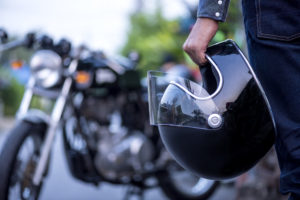There have been three motorcycle accident fatalities in the last 10 days in southern Utah – one because a motorcyclist hit a deer, one because a drunk driver hit a motorcyclist, and one because a motorcycle blew a tire and the rider could not ride out to safety. People ride motorcycles for any number of reasons that include good gas mileage, the open air experience, the thrill of connecting with the road in a way that one cannot in a car – the list goes on. But the lure of the motorcycle also leads danger because if you are in an accident on a motorcycle, your chances of being injured or killed rise dramatically.
In response, groups such as the Motorcycle Safety Foundation (MSF) offer a wealth of useful information to help make it safe for everyone on the road. The MSF highlights 5 key messages:
1. Get trained and licensed 2. Wear protective gear — all the gear, all the time — including a helmet manufactured to the standards set by the DOT 3. Ride unimpaired by alcohol or other drugs 4. Ride within your own skill limits 5. Be a lifelong learner by taking refresher rider courses
They also offer specific tips for car drivers:
Over half of all fatal motorcycle crashes involve another vehicle. Most of the time, the motorist, not the motorcyclist, is at fault. There are a lot more cars and trucks than motorcycles on the road, and some drivers don’t "recognize" a motorcycle – they ignore it (usually unintentionally).
Because of its small size, a motorcycle can be easily hidden in a car’s blind spots (door/roof pillars) or masked by objects or backgrounds outside a car (bushes, fences, bridges, etc). Take an extra moment to look for motorcycles, whether you’re changing lanes or turning at intersections.
Because of its small size, a motorcycle may look farther away than it is. It may also be difficult to judge a motorcycle’s speed. When checking traffic to turn at an intersection or into (or out of) a driveway, predict a motorcycle is closer than it looks.
Motorcyclists often slow by downshifting or merely rolling off the throttle, thus not activating the brake light. Allow more following distance, say 3 or 4 seconds. At intersections, predict a motorcyclist may slow down without visual warning.
Motorcyclists often adjust position within a lane to be seen more easily and to minimize the effects of road debris, passing vehicles, and wind. Understand that motorcyclists adjust lane position for a purpose, not to be reckless or show off or to allow you to share the lane with them.
Turn signals on a motorcycle usually are not self-canceling, thus some riders (especially beginners) sometimes forget to turn them off after a turn or lane change. Make sure a motorcycle’s signal is for real.
Maneuverability is one of a motorcycle’s better characteristics, especially at slower speeds and with good road conditions, but don’t expect a motorcyclist to always be able to dodge out of the way.
Stopping distance for motorcycles is nearly the same as for cars, but slippery pavement makes stopping quickly difficult. Allow more following distance behind a motorcycle because it can’t always stop "on a dime."
When a motorcycle is in motion, see more than the motorcycle – see the person under the helmet, who could be your friend, neighbor, or relative.
If a driver crashes into a motorcyclist, bicyclist, or pedestrian and causes serious injury, the driver would likely never forgive himself/herself.
And for motorcycle riders:
So whether you are in a car or on a motorcycle, be aware of your surroundings, think safety and enjoy the ride.

Bret Hanna of Wrona DuBois in Utah, focuses exclusively on litigating plaintiffs’ medical malpractice and catastrophic personal injury cases. He has represented clients in state and federal courts, in mediations, and in administrative proceedings in Michigan and Utah since 1991.










One Comment
Mike Bryant
Very nice lists of tips and ideas for riders. The number of rider deaths continue to grow, hopefully more people will heed these ideas.
Comments for this article are closed.